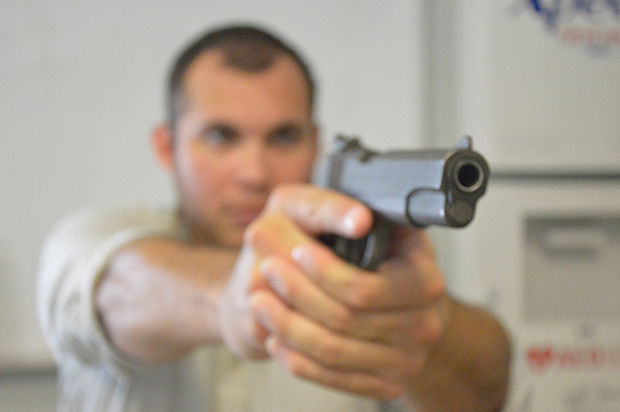Staring down the barrel: Concealed-carry laws subsidize differing opinions
Former Duquesne police officer Pablo Ortiz, junior business major, takes aim Sept. 10, 2015, at the Duquesne Police Department. Missouri remains one of a number of states that prohibits concealed carry completely.
While all 50 states have passed legislation to allow the carrying of concealed weapons with certain requirements, 20 states still uphold statutes that ban such action on college campuses; Missouri is one of those with such bans.
“In law enforcement we have the opinion that it is generally safer if weapons are not allowed at a school,” said Kenneth Kennedy, chief of University police. “The reason for that might be if someone in a classroom were to have a concealed-carry permit and they carried their weapon into that classroom, if a student were to get angry with another student he could just walk over to the person that has the gun, remove it from them, and then there is an armed confrontation.”
Another 23 states have moderate restrictions, but the ultimate decision on the matter falls into the hands of the respective universities within those states.
Seven states remain, and in those seven, legislation is in place to allow the carrying of concealed weapons on college campuses, most notably, Kansas.
Utah remains the only state naming public colleges and universities as public entities, thus giving the schools themselves no authority to ban such action. The remaining six states reserve the option to this point, with signage, voluntary training courses and “adequate security measures” acting as loopholes for restrictive sanctions.
“We train officers in the academy [when weapon use is a necessity],” said Kennedy. “Then they go through simulation exercises where they pull, basically an air gun, on a screen and we do ‘shoot, don’t shoot’ scenarios.”
In 2013, 19 pieces of state legislation in favor of carrying on campuses were proposed, but only two passed; in 2013, five states introduced similar legislation in favor of prohibiting carrying on campus; none passed.
“With the weapons I would say it would be better left to campus security personnel,” said Chase Phillips, Missouri Army National Guard member for eight years and current professor of military science. “They are the most formally trained to handle threats on campus.”
Keepgunsoffcampus.org, an anti-gun organization, continues to battle against the possibility of concealed guns on campuses, issuing a press release on Aug. 28, 2015, referencing “a series of disturbing campus incidents (including a death)” in a 48-hour period.
The incidents alluded to were a shooting resulting in a death at Savannah State University in Georgia, two shot in a parking lot at Texas Southern University in Houston and a gun-related arrest at Northern Kentucky University.
Since the shooting of 32 students on April 16, 2007, at Virginia Tech University, campus gun control has been debated. When University of Cincinnati police officer Ray Tensing allegedly used his university-issued weapon to kill Samuel Dubose, the intensity has reached an all-time high.
At this time Missouri Southern remains a non-carry campus, a sentiment current campus police agree with.
“Anything is a possibility but I see law enforcement being fairly united in this area, and would certainly lobby that it not happen,” said Kennedy.
Your donation will support the student journalists of Missouri Southern State University. Your contribution will allow us to purchase equipment and cover our annual website hosting costs.




























